Brand Management Report: Evaluating Brand Strategy for John Lewis
VerifiedAdded on 2023/01/19
|14
|4413
|67
Report
AI Summary
This report delves into the core concepts of brand management, using John Lewis as a practical case study. It begins by discussing the value of branding as a marketing tool and its emergence in business practices, emphasizing the importance of brand recognition and customer loyalty. The report then evaluates the components of brand strategy, focusing on brand equity management and the key elements that contribute to a successful brand. It further explores various strategies for brand equity management, including portfolio management and brand hierarchy, illustrating how these strategies can be applied to maintain and enhance a brand's value. The analysis extends to examining different ways brands are managed through collaboration and partnership at both global and domestic levels. Finally, the report identifies and evaluates tactics for measuring and managing brand value, providing organizational examples to support the theoretical concepts. Overall, the report offers a comprehensive overview of brand management, providing insights into how companies like John Lewis can build, maintain, and leverage their brand for sustained success.
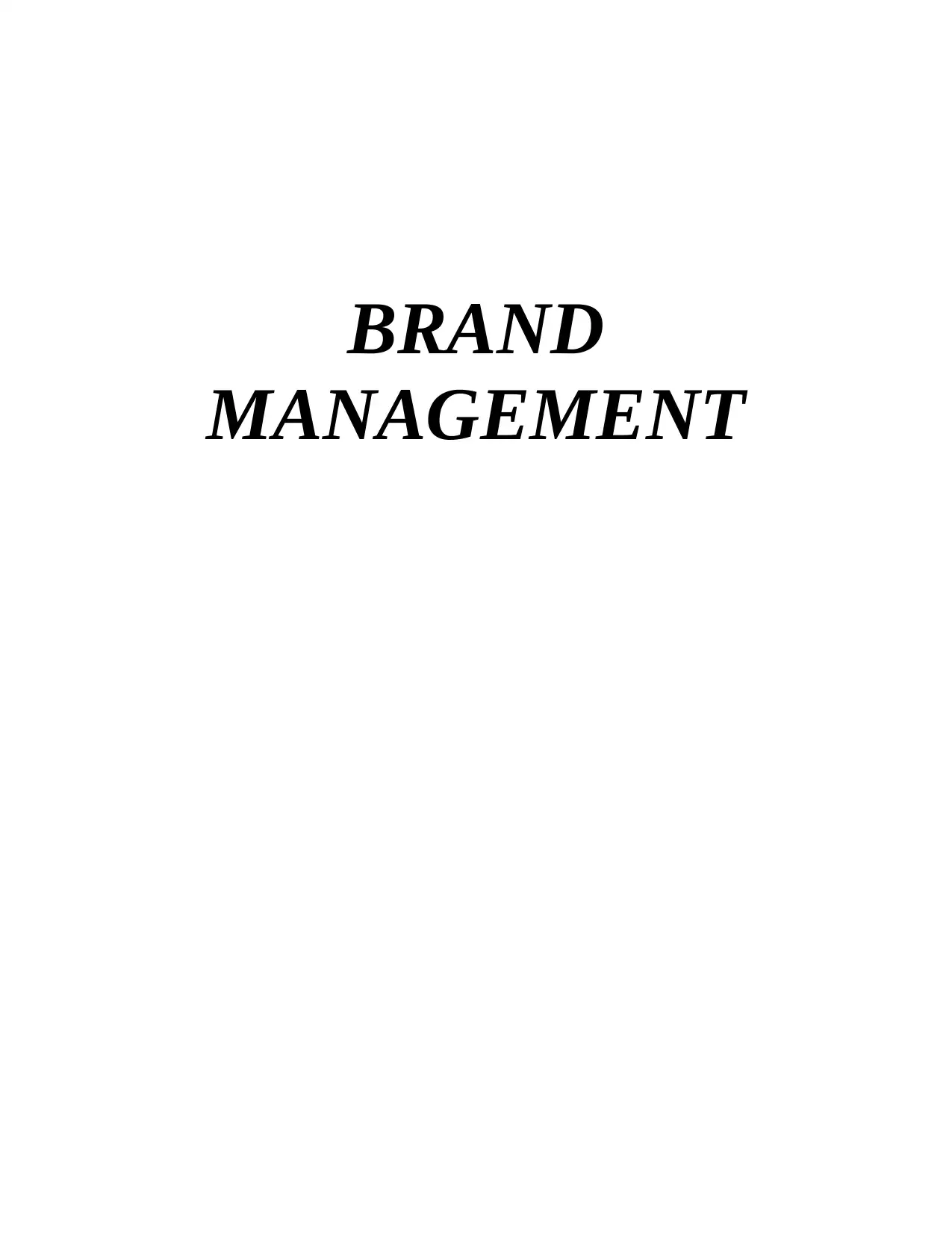
BRAND
MANAGEMENT
MANAGEMENT
Paraphrase This Document
Need a fresh take? Get an instant paraphrase of this document with our AI Paraphraser
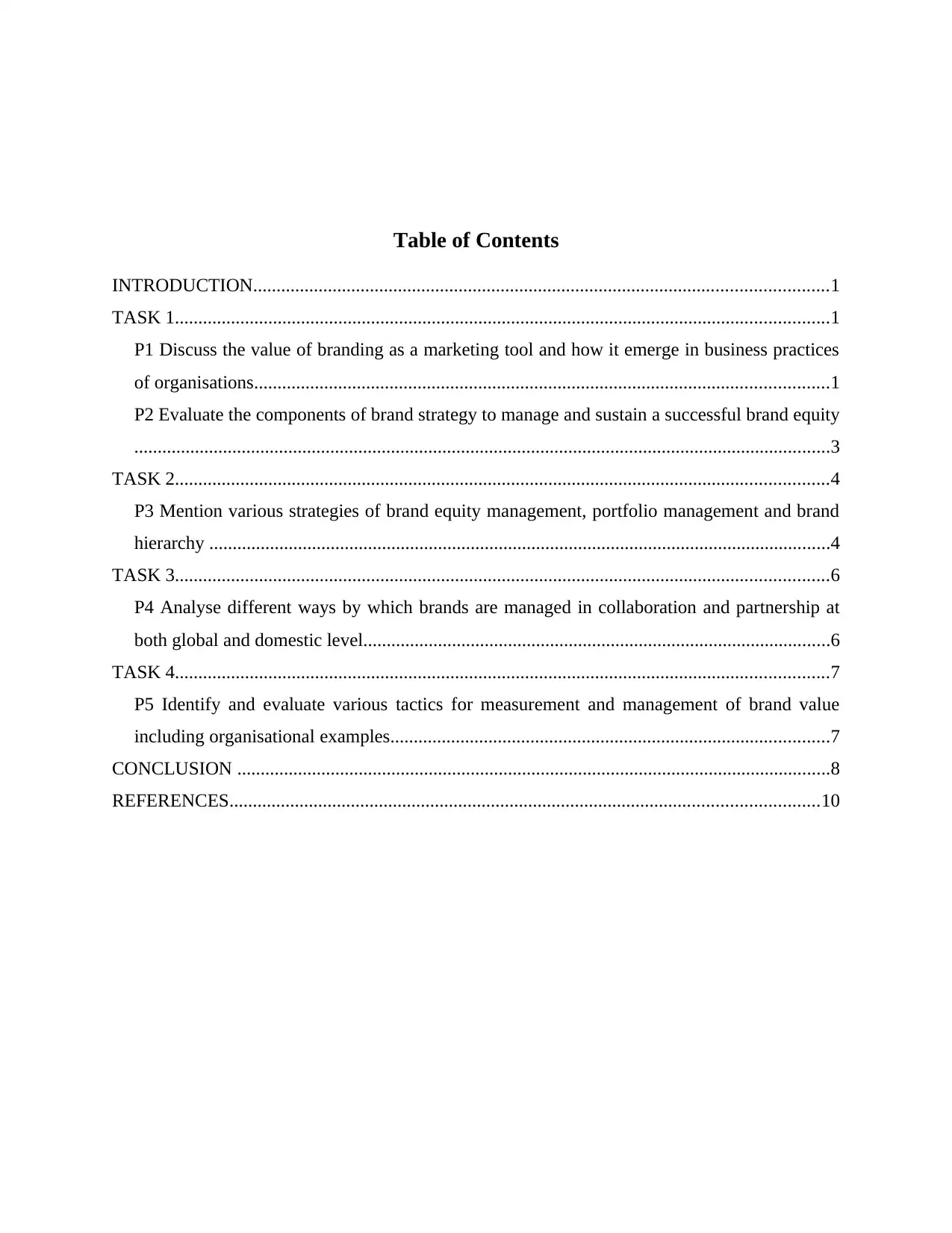
Table of Contents
INTRODUCTION...........................................................................................................................1
TASK 1............................................................................................................................................1
P1 Discuss the value of branding as a marketing tool and how it emerge in business practices
of organisations...........................................................................................................................1
P2 Evaluate the components of brand strategy to manage and sustain a successful brand equity
.....................................................................................................................................................3
TASK 2............................................................................................................................................4
P3 Mention various strategies of brand equity management, portfolio management and brand
hierarchy .....................................................................................................................................4
TASK 3............................................................................................................................................6
P4 Analyse different ways by which brands are managed in collaboration and partnership at
both global and domestic level....................................................................................................6
TASK 4............................................................................................................................................7
P5 Identify and evaluate various tactics for measurement and management of brand value
including organisational examples..............................................................................................7
CONCLUSION ...............................................................................................................................8
REFERENCES..............................................................................................................................10
INTRODUCTION...........................................................................................................................1
TASK 1............................................................................................................................................1
P1 Discuss the value of branding as a marketing tool and how it emerge in business practices
of organisations...........................................................................................................................1
P2 Evaluate the components of brand strategy to manage and sustain a successful brand equity
.....................................................................................................................................................3
TASK 2............................................................................................................................................4
P3 Mention various strategies of brand equity management, portfolio management and brand
hierarchy .....................................................................................................................................4
TASK 3............................................................................................................................................6
P4 Analyse different ways by which brands are managed in collaboration and partnership at
both global and domestic level....................................................................................................6
TASK 4............................................................................................................................................7
P5 Identify and evaluate various tactics for measurement and management of brand value
including organisational examples..............................................................................................7
CONCLUSION ...............................................................................................................................8
REFERENCES..............................................................................................................................10

⊘ This is a preview!⊘
Do you want full access?
Subscribe today to unlock all pages.

Trusted by 1+ million students worldwide
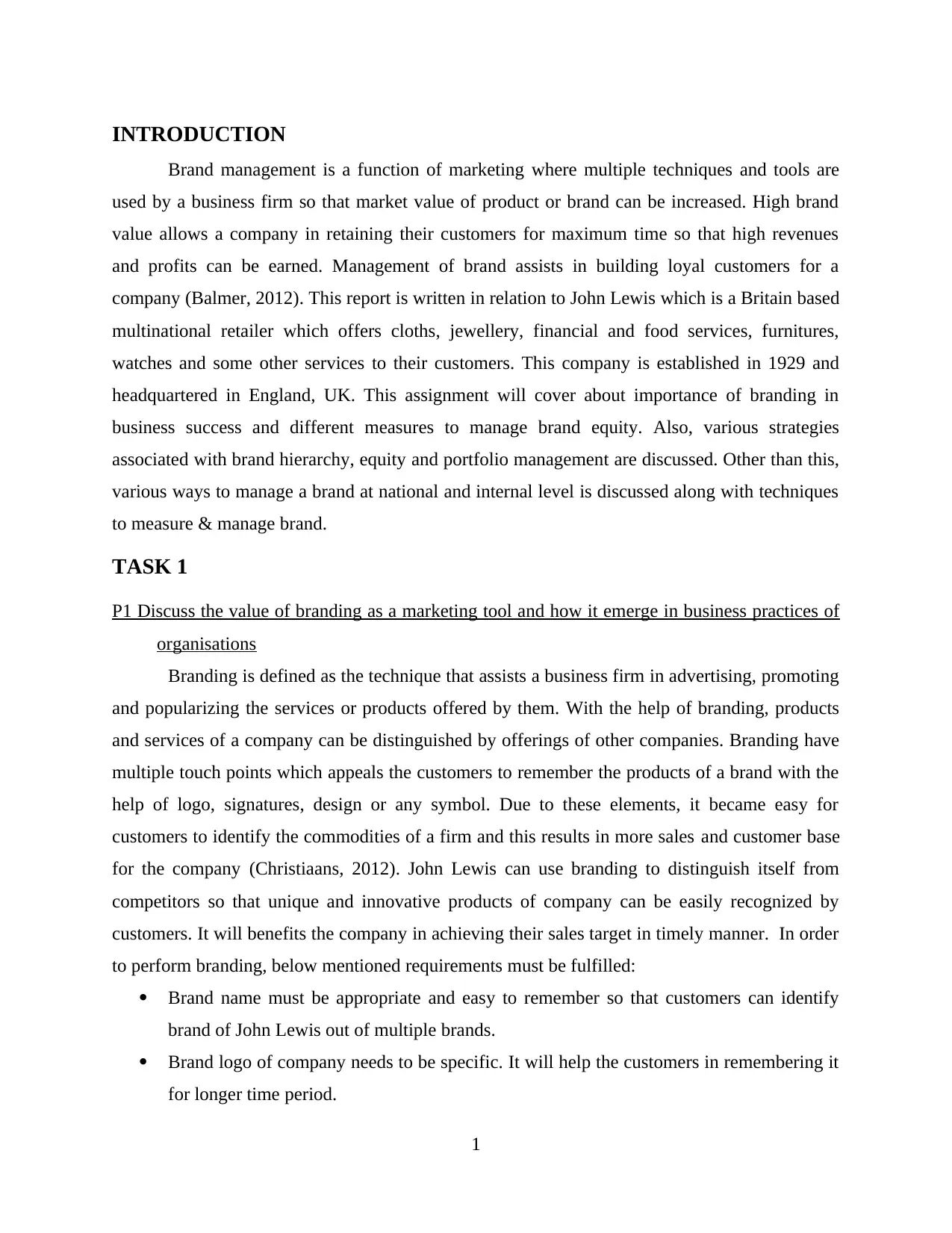
INTRODUCTION
Brand management is a function of marketing where multiple techniques and tools are
used by a business firm so that market value of product or brand can be increased. High brand
value allows a company in retaining their customers for maximum time so that high revenues
and profits can be earned. Management of brand assists in building loyal customers for a
company (Balmer, 2012). This report is written in relation to John Lewis which is a Britain based
multinational retailer which offers cloths, jewellery, financial and food services, furnitures,
watches and some other services to their customers. This company is established in 1929 and
headquartered in England, UK. This assignment will cover about importance of branding in
business success and different measures to manage brand equity. Also, various strategies
associated with brand hierarchy, equity and portfolio management are discussed. Other than this,
various ways to manage a brand at national and internal level is discussed along with techniques
to measure & manage brand.
TASK 1
P1 Discuss the value of branding as a marketing tool and how it emerge in business practices of
organisations
Branding is defined as the technique that assists a business firm in advertising, promoting
and popularizing the services or products offered by them. With the help of branding, products
and services of a company can be distinguished by offerings of other companies. Branding have
multiple touch points which appeals the customers to remember the products of a brand with the
help of logo, signatures, design or any symbol. Due to these elements, it became easy for
customers to identify the commodities of a firm and this results in more sales and customer base
for the company (Christiaans, 2012). John Lewis can use branding to distinguish itself from
competitors so that unique and innovative products of company can be easily recognized by
customers. It will benefits the company in achieving their sales target in timely manner. In order
to perform branding, below mentioned requirements must be fulfilled:
Brand name must be appropriate and easy to remember so that customers can identify
brand of John Lewis out of multiple brands.
Brand logo of company needs to be specific. It will help the customers in remembering it
for longer time period.
1
Brand management is a function of marketing where multiple techniques and tools are
used by a business firm so that market value of product or brand can be increased. High brand
value allows a company in retaining their customers for maximum time so that high revenues
and profits can be earned. Management of brand assists in building loyal customers for a
company (Balmer, 2012). This report is written in relation to John Lewis which is a Britain based
multinational retailer which offers cloths, jewellery, financial and food services, furnitures,
watches and some other services to their customers. This company is established in 1929 and
headquartered in England, UK. This assignment will cover about importance of branding in
business success and different measures to manage brand equity. Also, various strategies
associated with brand hierarchy, equity and portfolio management are discussed. Other than this,
various ways to manage a brand at national and internal level is discussed along with techniques
to measure & manage brand.
TASK 1
P1 Discuss the value of branding as a marketing tool and how it emerge in business practices of
organisations
Branding is defined as the technique that assists a business firm in advertising, promoting
and popularizing the services or products offered by them. With the help of branding, products
and services of a company can be distinguished by offerings of other companies. Branding have
multiple touch points which appeals the customers to remember the products of a brand with the
help of logo, signatures, design or any symbol. Due to these elements, it became easy for
customers to identify the commodities of a firm and this results in more sales and customer base
for the company (Christiaans, 2012). John Lewis can use branding to distinguish itself from
competitors so that unique and innovative products of company can be easily recognized by
customers. It will benefits the company in achieving their sales target in timely manner. In order
to perform branding, below mentioned requirements must be fulfilled:
Brand name must be appropriate and easy to remember so that customers can identify
brand of John Lewis out of multiple brands.
Brand logo of company needs to be specific. It will help the customers in remembering it
for longer time period.
1
Paraphrase This Document
Need a fresh take? Get an instant paraphrase of this document with our AI Paraphraser
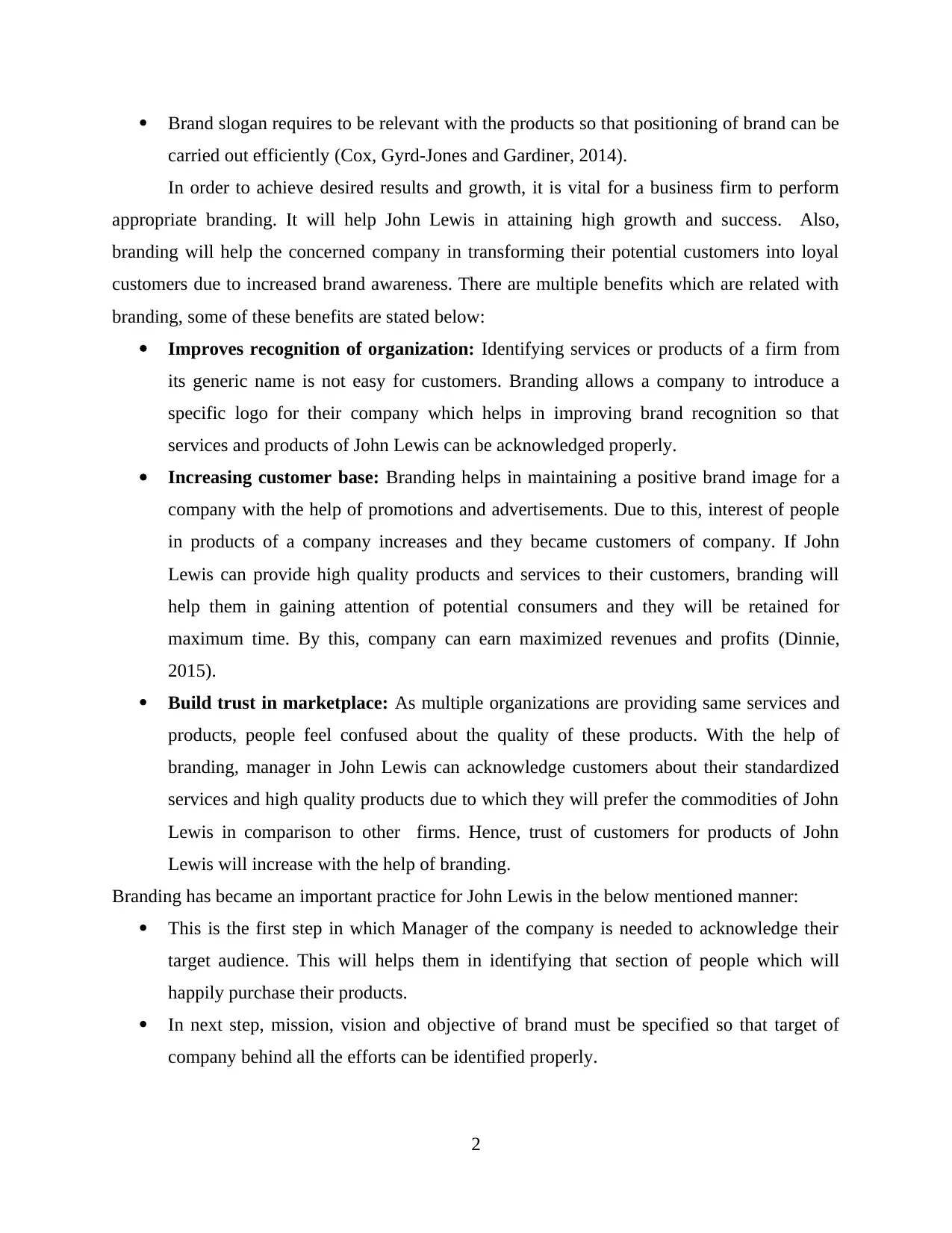
Brand slogan requires to be relevant with the products so that positioning of brand can be
carried out efficiently (Cox, Gyrd-Jones and Gardiner, 2014).
In order to achieve desired results and growth, it is vital for a business firm to perform
appropriate branding. It will help John Lewis in attaining high growth and success. Also,
branding will help the concerned company in transforming their potential customers into loyal
customers due to increased brand awareness. There are multiple benefits which are related with
branding, some of these benefits are stated below:
Improves recognition of organization: Identifying services or products of a firm from
its generic name is not easy for customers. Branding allows a company to introduce a
specific logo for their company which helps in improving brand recognition so that
services and products of John Lewis can be acknowledged properly.
Increasing customer base: Branding helps in maintaining a positive brand image for a
company with the help of promotions and advertisements. Due to this, interest of people
in products of a company increases and they became customers of company. If John
Lewis can provide high quality products and services to their customers, branding will
help them in gaining attention of potential consumers and they will be retained for
maximum time. By this, company can earn maximized revenues and profits (Dinnie,
2015).
Build trust in marketplace: As multiple organizations are providing same services and
products, people feel confused about the quality of these products. With the help of
branding, manager in John Lewis can acknowledge customers about their standardized
services and high quality products due to which they will prefer the commodities of John
Lewis in comparison to other firms. Hence, trust of customers for products of John
Lewis will increase with the help of branding.
Branding has became an important practice for John Lewis in the below mentioned manner:
This is the first step in which Manager of the company is needed to acknowledge their
target audience. This will helps them in identifying that section of people which will
happily purchase their products.
In next step, mission, vision and objective of brand must be specified so that target of
company behind all the efforts can be identified properly.
2
carried out efficiently (Cox, Gyrd-Jones and Gardiner, 2014).
In order to achieve desired results and growth, it is vital for a business firm to perform
appropriate branding. It will help John Lewis in attaining high growth and success. Also,
branding will help the concerned company in transforming their potential customers into loyal
customers due to increased brand awareness. There are multiple benefits which are related with
branding, some of these benefits are stated below:
Improves recognition of organization: Identifying services or products of a firm from
its generic name is not easy for customers. Branding allows a company to introduce a
specific logo for their company which helps in improving brand recognition so that
services and products of John Lewis can be acknowledged properly.
Increasing customer base: Branding helps in maintaining a positive brand image for a
company with the help of promotions and advertisements. Due to this, interest of people
in products of a company increases and they became customers of company. If John
Lewis can provide high quality products and services to their customers, branding will
help them in gaining attention of potential consumers and they will be retained for
maximum time. By this, company can earn maximized revenues and profits (Dinnie,
2015).
Build trust in marketplace: As multiple organizations are providing same services and
products, people feel confused about the quality of these products. With the help of
branding, manager in John Lewis can acknowledge customers about their standardized
services and high quality products due to which they will prefer the commodities of John
Lewis in comparison to other firms. Hence, trust of customers for products of John
Lewis will increase with the help of branding.
Branding has became an important practice for John Lewis in the below mentioned manner:
This is the first step in which Manager of the company is needed to acknowledge their
target audience. This will helps them in identifying that section of people which will
happily purchase their products.
In next step, mission, vision and objective of brand must be specified so that target of
company behind all the efforts can be identified properly.
2
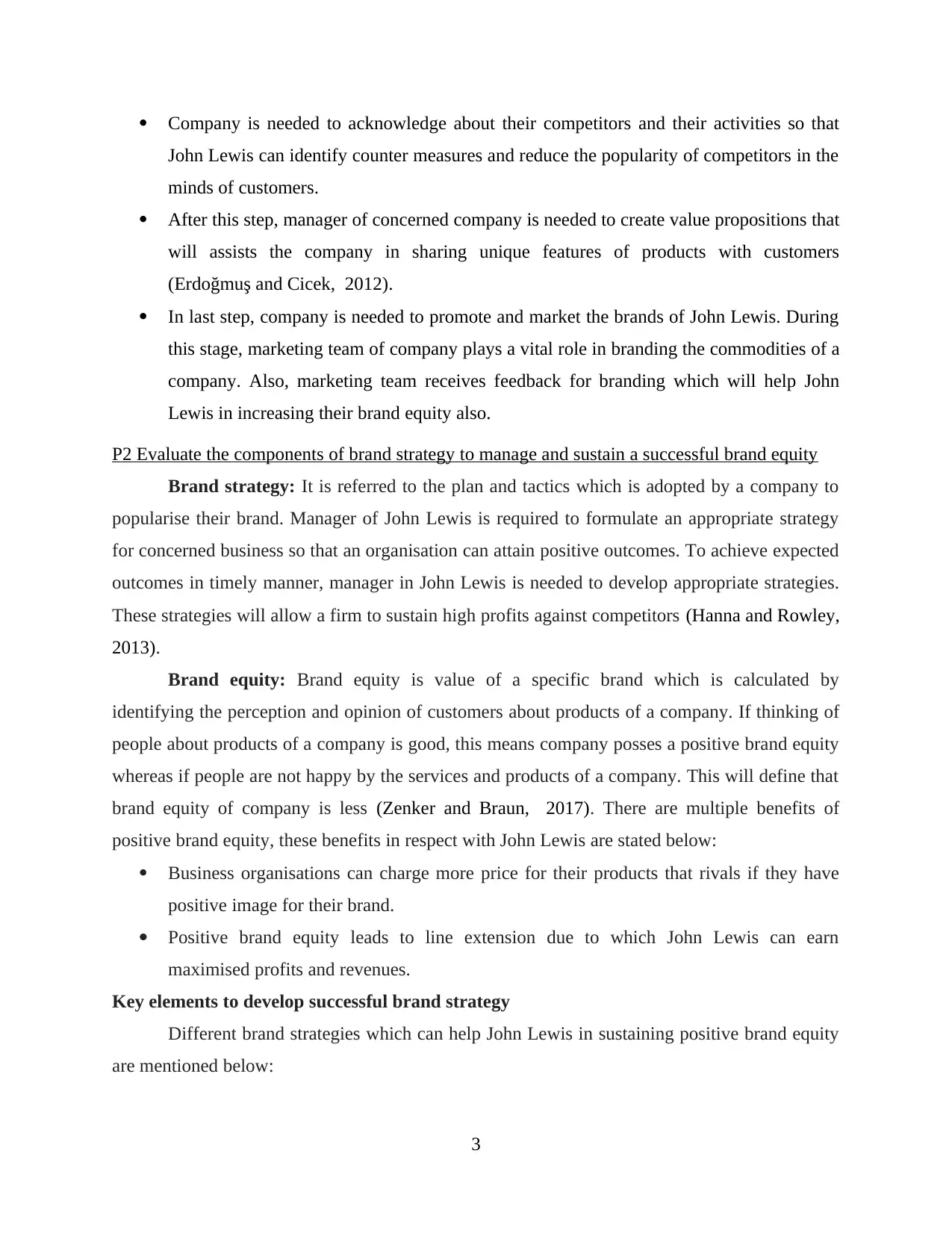
Company is needed to acknowledge about their competitors and their activities so that
John Lewis can identify counter measures and reduce the popularity of competitors in the
minds of customers.
After this step, manager of concerned company is needed to create value propositions that
will assists the company in sharing unique features of products with customers
(Erdoğmuş and Cicek, 2012).
In last step, company is needed to promote and market the brands of John Lewis. During
this stage, marketing team of company plays a vital role in branding the commodities of a
company. Also, marketing team receives feedback for branding which will help John
Lewis in increasing their brand equity also.
P2 Evaluate the components of brand strategy to manage and sustain a successful brand equity
Brand strategy: It is referred to the plan and tactics which is adopted by a company to
popularise their brand. Manager of John Lewis is required to formulate an appropriate strategy
for concerned business so that an organisation can attain positive outcomes. To achieve expected
outcomes in timely manner, manager in John Lewis is needed to develop appropriate strategies.
These strategies will allow a firm to sustain high profits against competitors (Hanna and Rowley,
2013).
Brand equity: Brand equity is value of a specific brand which is calculated by
identifying the perception and opinion of customers about products of a company. If thinking of
people about products of a company is good, this means company posses a positive brand equity
whereas if people are not happy by the services and products of a company. This will define that
brand equity of company is less (Zenker and Braun, 2017). There are multiple benefits of
positive brand equity, these benefits in respect with John Lewis are stated below:
Business organisations can charge more price for their products that rivals if they have
positive image for their brand.
Positive brand equity leads to line extension due to which John Lewis can earn
maximised profits and revenues.
Key elements to develop successful brand strategy
Different brand strategies which can help John Lewis in sustaining positive brand equity
are mentioned below:
3
John Lewis can identify counter measures and reduce the popularity of competitors in the
minds of customers.
After this step, manager of concerned company is needed to create value propositions that
will assists the company in sharing unique features of products with customers
(Erdoğmuş and Cicek, 2012).
In last step, company is needed to promote and market the brands of John Lewis. During
this stage, marketing team of company plays a vital role in branding the commodities of a
company. Also, marketing team receives feedback for branding which will help John
Lewis in increasing their brand equity also.
P2 Evaluate the components of brand strategy to manage and sustain a successful brand equity
Brand strategy: It is referred to the plan and tactics which is adopted by a company to
popularise their brand. Manager of John Lewis is required to formulate an appropriate strategy
for concerned business so that an organisation can attain positive outcomes. To achieve expected
outcomes in timely manner, manager in John Lewis is needed to develop appropriate strategies.
These strategies will allow a firm to sustain high profits against competitors (Hanna and Rowley,
2013).
Brand equity: Brand equity is value of a specific brand which is calculated by
identifying the perception and opinion of customers about products of a company. If thinking of
people about products of a company is good, this means company posses a positive brand equity
whereas if people are not happy by the services and products of a company. This will define that
brand equity of company is less (Zenker and Braun, 2017). There are multiple benefits of
positive brand equity, these benefits in respect with John Lewis are stated below:
Business organisations can charge more price for their products that rivals if they have
positive image for their brand.
Positive brand equity leads to line extension due to which John Lewis can earn
maximised profits and revenues.
Key elements to develop successful brand strategy
Different brand strategies which can help John Lewis in sustaining positive brand equity
are mentioned below:
3
⊘ This is a preview!⊘
Do you want full access?
Subscribe today to unlock all pages.

Trusted by 1+ million students worldwide
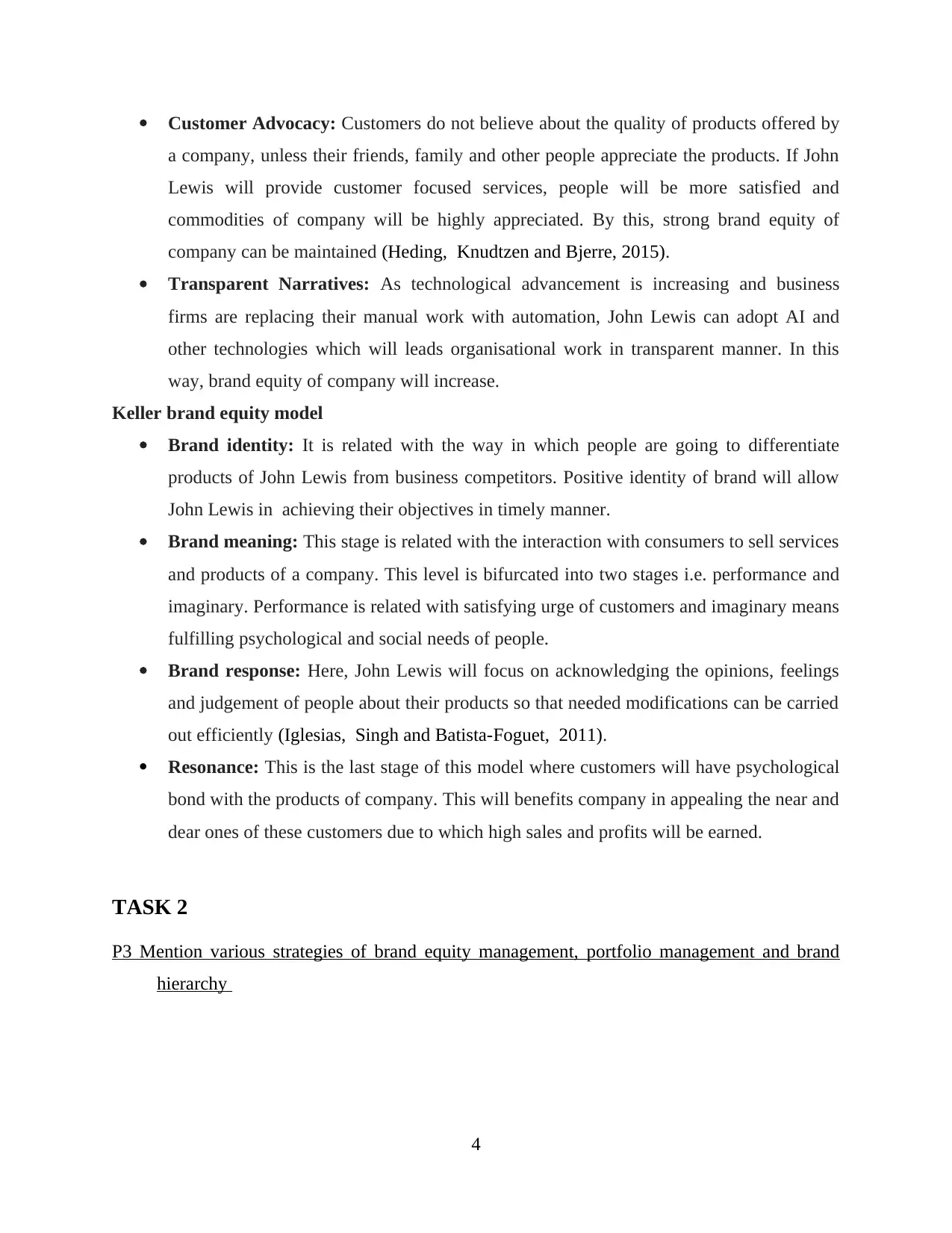
Customer Advocacy: Customers do not believe about the quality of products offered by
a company, unless their friends, family and other people appreciate the products. If John
Lewis will provide customer focused services, people will be more satisfied and
commodities of company will be highly appreciated. By this, strong brand equity of
company can be maintained (Heding, Knudtzen and Bjerre, 2015).
Transparent Narratives: As technological advancement is increasing and business
firms are replacing their manual work with automation, John Lewis can adopt AI and
other technologies which will leads organisational work in transparent manner. In this
way, brand equity of company will increase.
Keller brand equity model
Brand identity: It is related with the way in which people are going to differentiate
products of John Lewis from business competitors. Positive identity of brand will allow
John Lewis in achieving their objectives in timely manner.
Brand meaning: This stage is related with the interaction with consumers to sell services
and products of a company. This level is bifurcated into two stages i.e. performance and
imaginary. Performance is related with satisfying urge of customers and imaginary means
fulfilling psychological and social needs of people.
Brand response: Here, John Lewis will focus on acknowledging the opinions, feelings
and judgement of people about their products so that needed modifications can be carried
out efficiently (Iglesias, Singh and Batista-Foguet, 2011).
Resonance: This is the last stage of this model where customers will have psychological
bond with the products of company. This will benefits company in appealing the near and
dear ones of these customers due to which high sales and profits will be earned.
TASK 2
P3 Mention various strategies of brand equity management, portfolio management and brand
hierarchy
4
a company, unless their friends, family and other people appreciate the products. If John
Lewis will provide customer focused services, people will be more satisfied and
commodities of company will be highly appreciated. By this, strong brand equity of
company can be maintained (Heding, Knudtzen and Bjerre, 2015).
Transparent Narratives: As technological advancement is increasing and business
firms are replacing their manual work with automation, John Lewis can adopt AI and
other technologies which will leads organisational work in transparent manner. In this
way, brand equity of company will increase.
Keller brand equity model
Brand identity: It is related with the way in which people are going to differentiate
products of John Lewis from business competitors. Positive identity of brand will allow
John Lewis in achieving their objectives in timely manner.
Brand meaning: This stage is related with the interaction with consumers to sell services
and products of a company. This level is bifurcated into two stages i.e. performance and
imaginary. Performance is related with satisfying urge of customers and imaginary means
fulfilling psychological and social needs of people.
Brand response: Here, John Lewis will focus on acknowledging the opinions, feelings
and judgement of people about their products so that needed modifications can be carried
out efficiently (Iglesias, Singh and Batista-Foguet, 2011).
Resonance: This is the last stage of this model where customers will have psychological
bond with the products of company. This will benefits company in appealing the near and
dear ones of these customers due to which high sales and profits will be earned.
TASK 2
P3 Mention various strategies of brand equity management, portfolio management and brand
hierarchy
4
Paraphrase This Document
Need a fresh take? Get an instant paraphrase of this document with our AI Paraphraser
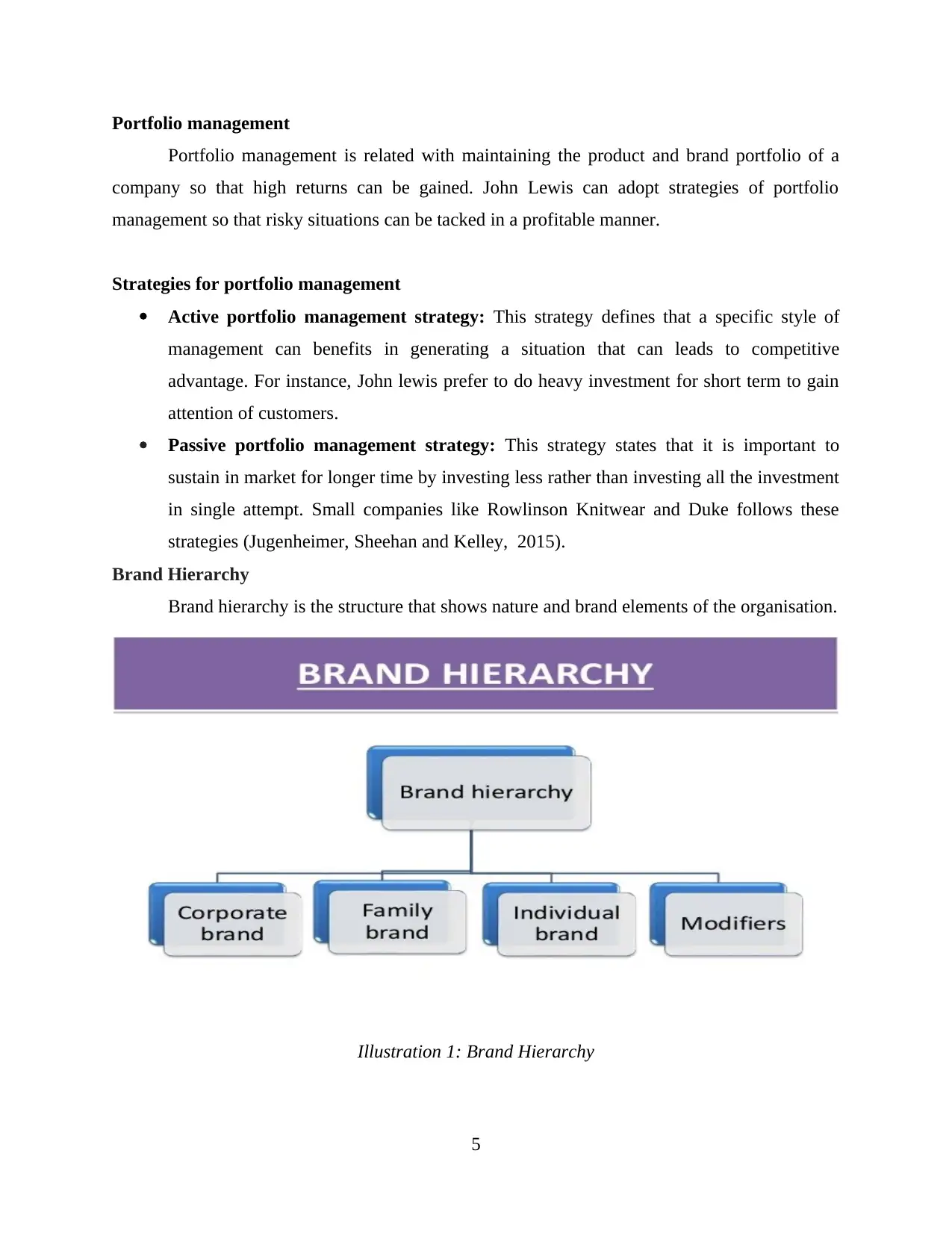
Portfolio management
Portfolio management is related with maintaining the product and brand portfolio of a
company so that high returns can be gained. John Lewis can adopt strategies of portfolio
management so that risky situations can be tacked in a profitable manner.
Strategies for portfolio management
Active portfolio management strategy: This strategy defines that a specific style of
management can benefits in generating a situation that can leads to competitive
advantage. For instance, John lewis prefer to do heavy investment for short term to gain
attention of customers.
Passive portfolio management strategy: This strategy states that it is important to
sustain in market for longer time by investing less rather than investing all the investment
in single attempt. Small companies like Rowlinson Knitwear and Duke follows these
strategies (Jugenheimer, Sheehan and Kelley, 2015).
Brand Hierarchy
Brand hierarchy is the structure that shows nature and brand elements of the organisation.
Illustration 1: Brand Hierarchy
5
Portfolio management is related with maintaining the product and brand portfolio of a
company so that high returns can be gained. John Lewis can adopt strategies of portfolio
management so that risky situations can be tacked in a profitable manner.
Strategies for portfolio management
Active portfolio management strategy: This strategy defines that a specific style of
management can benefits in generating a situation that can leads to competitive
advantage. For instance, John lewis prefer to do heavy investment for short term to gain
attention of customers.
Passive portfolio management strategy: This strategy states that it is important to
sustain in market for longer time by investing less rather than investing all the investment
in single attempt. Small companies like Rowlinson Knitwear and Duke follows these
strategies (Jugenheimer, Sheehan and Kelley, 2015).
Brand Hierarchy
Brand hierarchy is the structure that shows nature and brand elements of the organisation.
Illustration 1: Brand Hierarchy
5
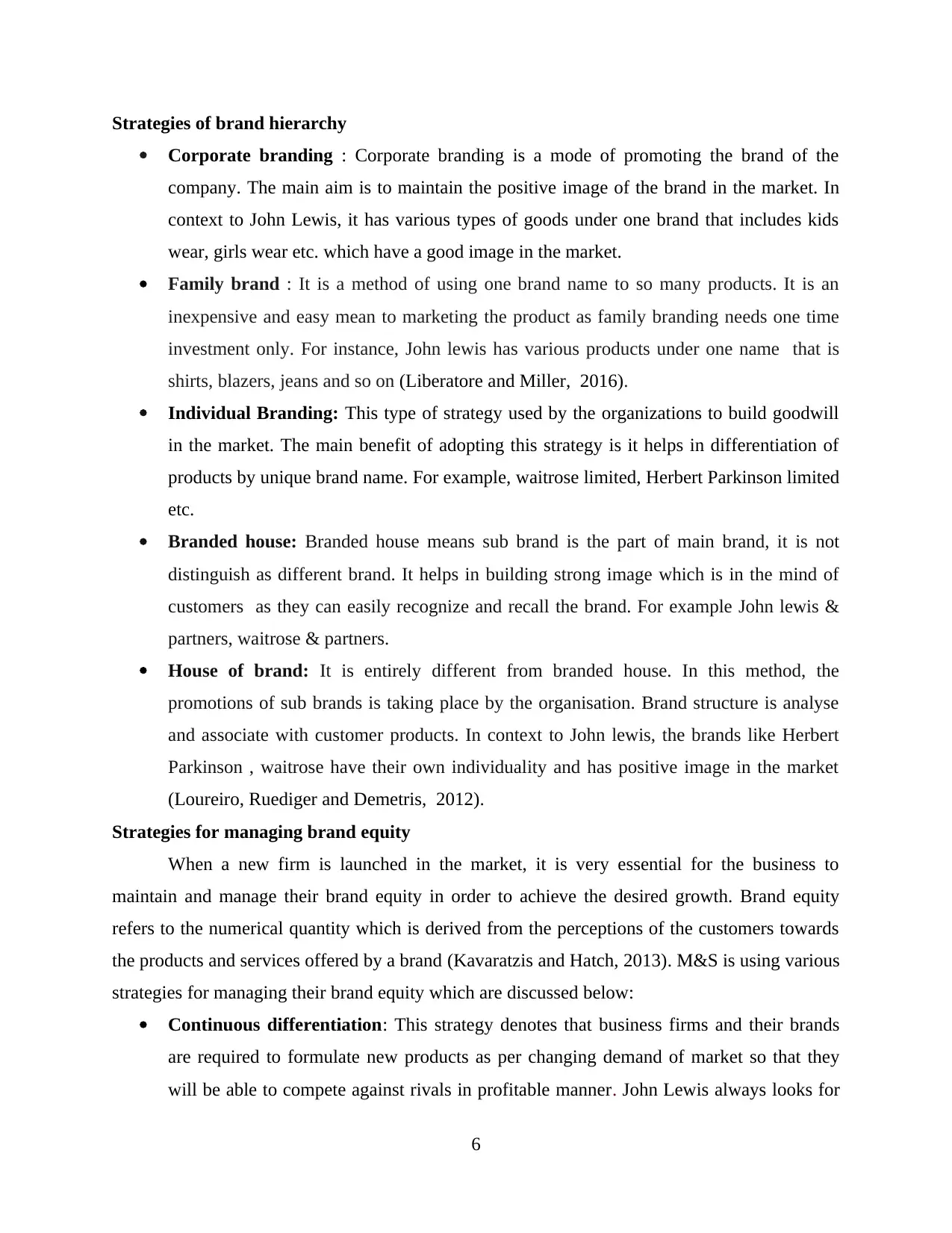
Strategies of brand hierarchy
Corporate branding : Corporate branding is a mode of promoting the brand of the
company. The main aim is to maintain the positive image of the brand in the market. In
context to John Lewis, it has various types of goods under one brand that includes kids
wear, girls wear etc. which have a good image in the market.
Family brand : It is a method of using one brand name to so many products. It is an
inexpensive and easy mean to marketing the product as family branding needs one time
investment only. For instance, John lewis has various products under one name that is
shirts, blazers, jeans and so on (Liberatore and Miller, 2016).
Individual Branding: This type of strategy used by the organizations to build goodwill
in the market. The main benefit of adopting this strategy is it helps in differentiation of
products by unique brand name. For example, waitrose limited, Herbert Parkinson limited
etc.
Branded house: Branded house means sub brand is the part of main brand, it is not
distinguish as different brand. It helps in building strong image which is in the mind of
customers as they can easily recognize and recall the brand. For example John lewis &
partners, waitrose & partners.
House of brand: It is entirely different from branded house. In this method, the
promotions of sub brands is taking place by the organisation. Brand structure is analyse
and associate with customer products. In context to John lewis, the brands like Herbert
Parkinson , waitrose have their own individuality and has positive image in the market
(Loureiro, Ruediger and Demetris, 2012).
Strategies for managing brand equity
When a new firm is launched in the market, it is very essential for the business to
maintain and manage their brand equity in order to achieve the desired growth. Brand equity
refers to the numerical quantity which is derived from the perceptions of the customers towards
the products and services offered by a brand (Kavaratzis and Hatch, 2013). M&S is using various
strategies for managing their brand equity which are discussed below:
Continuous differentiation: This strategy denotes that business firms and their brands
are required to formulate new products as per changing demand of market so that they
will be able to compete against rivals in profitable manner. John Lewis always looks for
6
Corporate branding : Corporate branding is a mode of promoting the brand of the
company. The main aim is to maintain the positive image of the brand in the market. In
context to John Lewis, it has various types of goods under one brand that includes kids
wear, girls wear etc. which have a good image in the market.
Family brand : It is a method of using one brand name to so many products. It is an
inexpensive and easy mean to marketing the product as family branding needs one time
investment only. For instance, John lewis has various products under one name that is
shirts, blazers, jeans and so on (Liberatore and Miller, 2016).
Individual Branding: This type of strategy used by the organizations to build goodwill
in the market. The main benefit of adopting this strategy is it helps in differentiation of
products by unique brand name. For example, waitrose limited, Herbert Parkinson limited
etc.
Branded house: Branded house means sub brand is the part of main brand, it is not
distinguish as different brand. It helps in building strong image which is in the mind of
customers as they can easily recognize and recall the brand. For example John lewis &
partners, waitrose & partners.
House of brand: It is entirely different from branded house. In this method, the
promotions of sub brands is taking place by the organisation. Brand structure is analyse
and associate with customer products. In context to John lewis, the brands like Herbert
Parkinson , waitrose have their own individuality and has positive image in the market
(Loureiro, Ruediger and Demetris, 2012).
Strategies for managing brand equity
When a new firm is launched in the market, it is very essential for the business to
maintain and manage their brand equity in order to achieve the desired growth. Brand equity
refers to the numerical quantity which is derived from the perceptions of the customers towards
the products and services offered by a brand (Kavaratzis and Hatch, 2013). M&S is using various
strategies for managing their brand equity which are discussed below:
Continuous differentiation: This strategy denotes that business firms and their brands
are required to formulate new products as per changing demand of market so that they
will be able to compete against rivals in profitable manner. John Lewis always looks for
6
⊘ This is a preview!⊘
Do you want full access?
Subscribe today to unlock all pages.

Trusted by 1+ million students worldwide
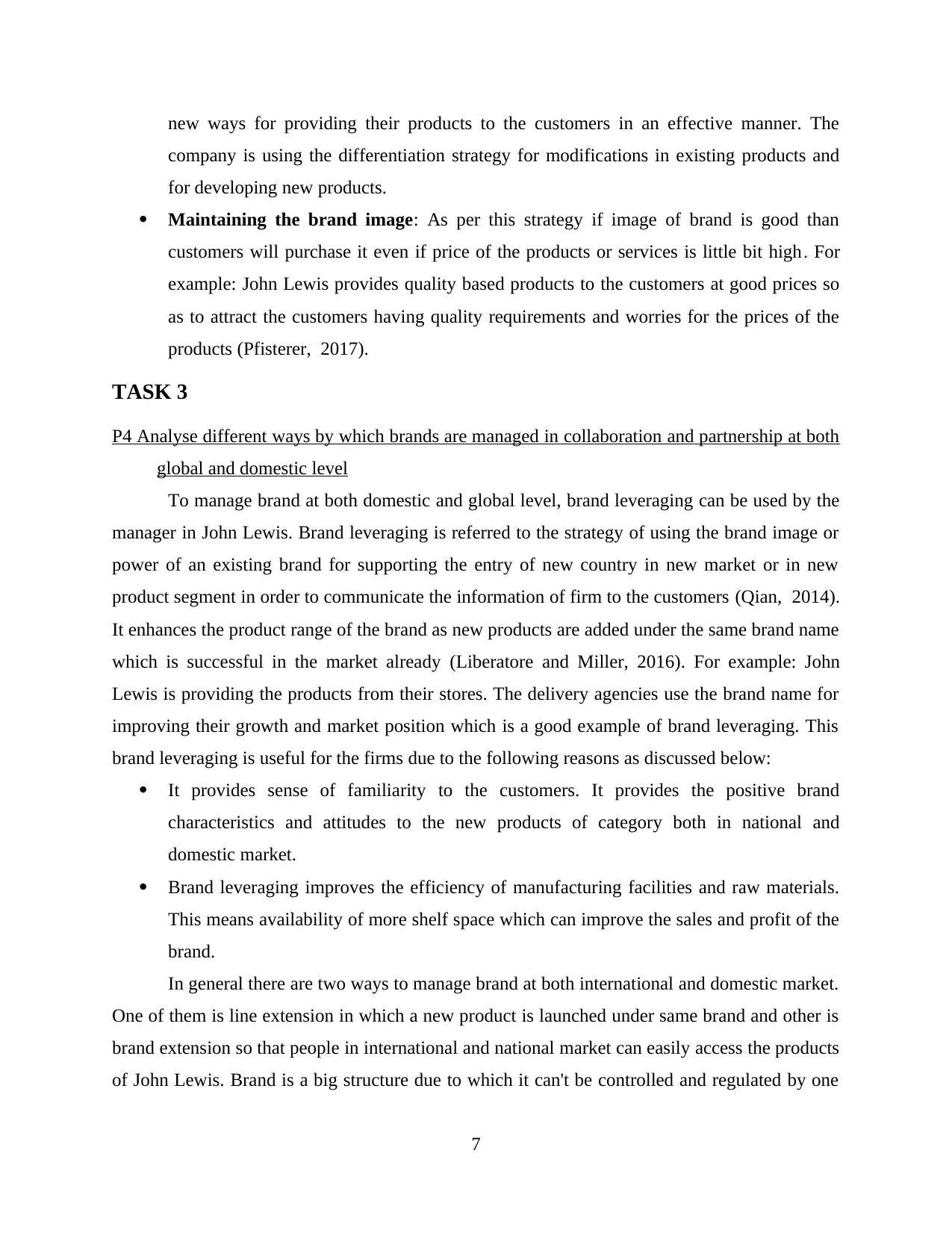
new ways for providing their products to the customers in an effective manner. The
company is using the differentiation strategy for modifications in existing products and
for developing new products.
Maintaining the brand image: As per this strategy if image of brand is good than
customers will purchase it even if price of the products or services is little bit high. For
example: John Lewis provides quality based products to the customers at good prices so
as to attract the customers having quality requirements and worries for the prices of the
products (Pfisterer, 2017).
TASK 3
P4 Analyse different ways by which brands are managed in collaboration and partnership at both
global and domestic level
To manage brand at both domestic and global level, brand leveraging can be used by the
manager in John Lewis. Brand leveraging is referred to the strategy of using the brand image or
power of an existing brand for supporting the entry of new country in new market or in new
product segment in order to communicate the information of firm to the customers (Qian, 2014).
It enhances the product range of the brand as new products are added under the same brand name
which is successful in the market already (Liberatore and Miller, 2016). For example: John
Lewis is providing the products from their stores. The delivery agencies use the brand name for
improving their growth and market position which is a good example of brand leveraging. This
brand leveraging is useful for the firms due to the following reasons as discussed below:
It provides sense of familiarity to the customers. It provides the positive brand
characteristics and attitudes to the new products of category both in national and
domestic market.
Brand leveraging improves the efficiency of manufacturing facilities and raw materials.
This means availability of more shelf space which can improve the sales and profit of the
brand.
In general there are two ways to manage brand at both international and domestic market.
One of them is line extension in which a new product is launched under same brand and other is
brand extension so that people in international and national market can easily access the products
of John Lewis. Brand is a big structure due to which it can't be controlled and regulated by one
7
company is using the differentiation strategy for modifications in existing products and
for developing new products.
Maintaining the brand image: As per this strategy if image of brand is good than
customers will purchase it even if price of the products or services is little bit high. For
example: John Lewis provides quality based products to the customers at good prices so
as to attract the customers having quality requirements and worries for the prices of the
products (Pfisterer, 2017).
TASK 3
P4 Analyse different ways by which brands are managed in collaboration and partnership at both
global and domestic level
To manage brand at both domestic and global level, brand leveraging can be used by the
manager in John Lewis. Brand leveraging is referred to the strategy of using the brand image or
power of an existing brand for supporting the entry of new country in new market or in new
product segment in order to communicate the information of firm to the customers (Qian, 2014).
It enhances the product range of the brand as new products are added under the same brand name
which is successful in the market already (Liberatore and Miller, 2016). For example: John
Lewis is providing the products from their stores. The delivery agencies use the brand name for
improving their growth and market position which is a good example of brand leveraging. This
brand leveraging is useful for the firms due to the following reasons as discussed below:
It provides sense of familiarity to the customers. It provides the positive brand
characteristics and attitudes to the new products of category both in national and
domestic market.
Brand leveraging improves the efficiency of manufacturing facilities and raw materials.
This means availability of more shelf space which can improve the sales and profit of the
brand.
In general there are two ways to manage brand at both international and domestic market.
One of them is line extension in which a new product is launched under same brand and other is
brand extension so that people in international and national market can easily access the products
of John Lewis. Brand is a big structure due to which it can't be controlled and regulated by one
7
Paraphrase This Document
Need a fresh take? Get an instant paraphrase of this document with our AI Paraphraser
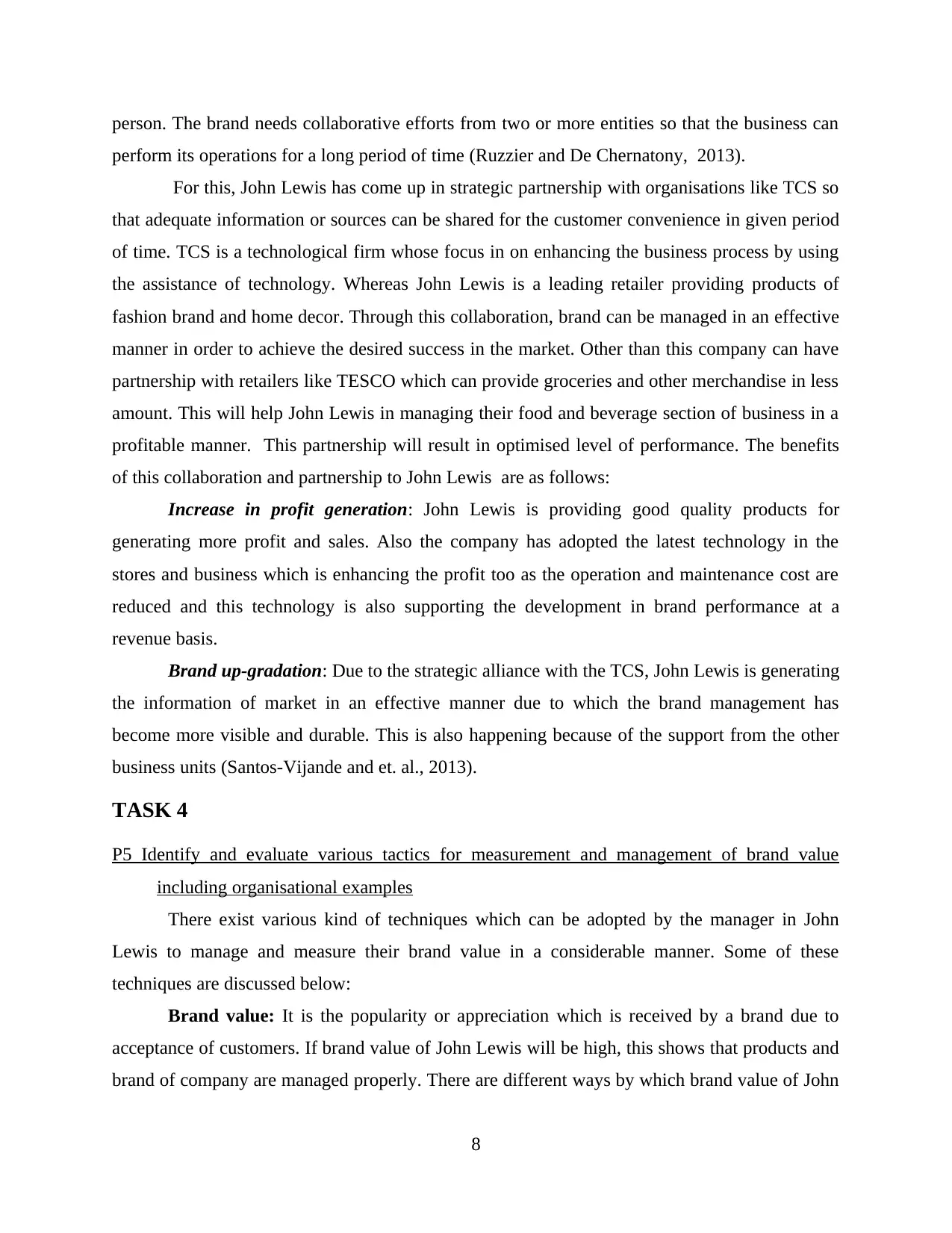
person. The brand needs collaborative efforts from two or more entities so that the business can
perform its operations for a long period of time (Ruzzier and De Chernatony, 2013).
For this, John Lewis has come up in strategic partnership with organisations like TCS so
that adequate information or sources can be shared for the customer convenience in given period
of time. TCS is a technological firm whose focus in on enhancing the business process by using
the assistance of technology. Whereas John Lewis is a leading retailer providing products of
fashion brand and home decor. Through this collaboration, brand can be managed in an effective
manner in order to achieve the desired success in the market. Other than this company can have
partnership with retailers like TESCO which can provide groceries and other merchandise in less
amount. This will help John Lewis in managing their food and beverage section of business in a
profitable manner. This partnership will result in optimised level of performance. The benefits
of this collaboration and partnership to John Lewis are as follows:
Increase in profit generation: John Lewis is providing good quality products for
generating more profit and sales. Also the company has adopted the latest technology in the
stores and business which is enhancing the profit too as the operation and maintenance cost are
reduced and this technology is also supporting the development in brand performance at a
revenue basis.
Brand up-gradation: Due to the strategic alliance with the TCS, John Lewis is generating
the information of market in an effective manner due to which the brand management has
become more visible and durable. This is also happening because of the support from the other
business units (Santos-Vijande and et. al., 2013).
TASK 4
P5 Identify and evaluate various tactics for measurement and management of brand value
including organisational examples
There exist various kind of techniques which can be adopted by the manager in John
Lewis to manage and measure their brand value in a considerable manner. Some of these
techniques are discussed below:
Brand value: It is the popularity or appreciation which is received by a brand due to
acceptance of customers. If brand value of John Lewis will be high, this shows that products and
brand of company are managed properly. There are different ways by which brand value of John
8
perform its operations for a long period of time (Ruzzier and De Chernatony, 2013).
For this, John Lewis has come up in strategic partnership with organisations like TCS so
that adequate information or sources can be shared for the customer convenience in given period
of time. TCS is a technological firm whose focus in on enhancing the business process by using
the assistance of technology. Whereas John Lewis is a leading retailer providing products of
fashion brand and home decor. Through this collaboration, brand can be managed in an effective
manner in order to achieve the desired success in the market. Other than this company can have
partnership with retailers like TESCO which can provide groceries and other merchandise in less
amount. This will help John Lewis in managing their food and beverage section of business in a
profitable manner. This partnership will result in optimised level of performance. The benefits
of this collaboration and partnership to John Lewis are as follows:
Increase in profit generation: John Lewis is providing good quality products for
generating more profit and sales. Also the company has adopted the latest technology in the
stores and business which is enhancing the profit too as the operation and maintenance cost are
reduced and this technology is also supporting the development in brand performance at a
revenue basis.
Brand up-gradation: Due to the strategic alliance with the TCS, John Lewis is generating
the information of market in an effective manner due to which the brand management has
become more visible and durable. This is also happening because of the support from the other
business units (Santos-Vijande and et. al., 2013).
TASK 4
P5 Identify and evaluate various tactics for measurement and management of brand value
including organisational examples
There exist various kind of techniques which can be adopted by the manager in John
Lewis to manage and measure their brand value in a considerable manner. Some of these
techniques are discussed below:
Brand value: It is the popularity or appreciation which is received by a brand due to
acceptance of customers. If brand value of John Lewis will be high, this shows that products and
brand of company are managed properly. There are different ways by which brand value of John
8
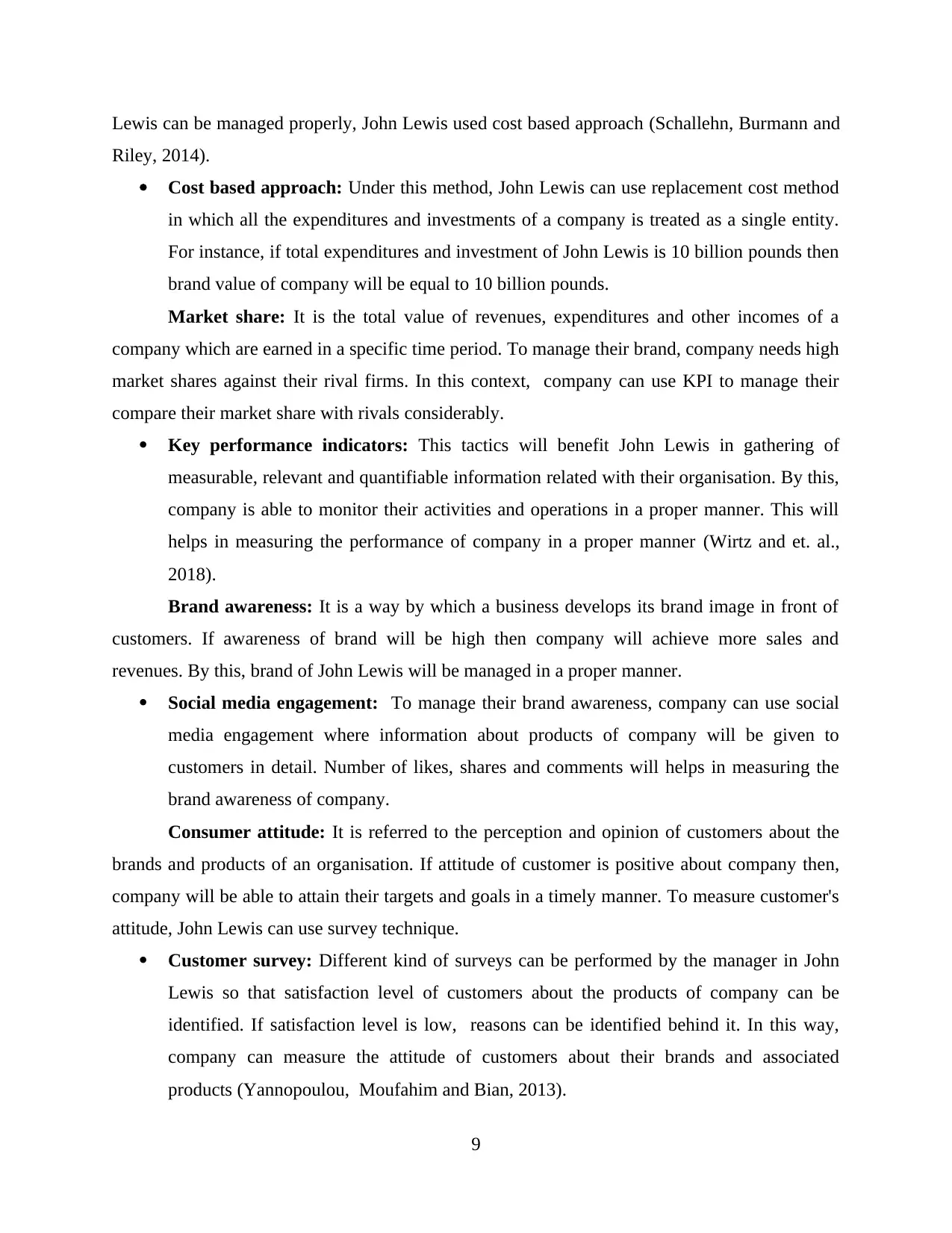
Lewis can be managed properly, John Lewis used cost based approach (Schallehn, Burmann and
Riley, 2014).
Cost based approach: Under this method, John Lewis can use replacement cost method
in which all the expenditures and investments of a company is treated as a single entity.
For instance, if total expenditures and investment of John Lewis is 10 billion pounds then
brand value of company will be equal to 10 billion pounds.
Market share: It is the total value of revenues, expenditures and other incomes of a
company which are earned in a specific time period. To manage their brand, company needs high
market shares against their rival firms. In this context, company can use KPI to manage their
compare their market share with rivals considerably.
Key performance indicators: This tactics will benefit John Lewis in gathering of
measurable, relevant and quantifiable information related with their organisation. By this,
company is able to monitor their activities and operations in a proper manner. This will
helps in measuring the performance of company in a proper manner (Wirtz and et. al.,
2018).
Brand awareness: It is a way by which a business develops its brand image in front of
customers. If awareness of brand will be high then company will achieve more sales and
revenues. By this, brand of John Lewis will be managed in a proper manner.
Social media engagement: To manage their brand awareness, company can use social
media engagement where information about products of company will be given to
customers in detail. Number of likes, shares and comments will helps in measuring the
brand awareness of company.
Consumer attitude: It is referred to the perception and opinion of customers about the
brands and products of an organisation. If attitude of customer is positive about company then,
company will be able to attain their targets and goals in a timely manner. To measure customer's
attitude, John Lewis can use survey technique.
Customer survey: Different kind of surveys can be performed by the manager in John
Lewis so that satisfaction level of customers about the products of company can be
identified. If satisfaction level is low, reasons can be identified behind it. In this way,
company can measure the attitude of customers about their brands and associated
products (Yannopoulou, Moufahim and Bian, 2013).
9
Riley, 2014).
Cost based approach: Under this method, John Lewis can use replacement cost method
in which all the expenditures and investments of a company is treated as a single entity.
For instance, if total expenditures and investment of John Lewis is 10 billion pounds then
brand value of company will be equal to 10 billion pounds.
Market share: It is the total value of revenues, expenditures and other incomes of a
company which are earned in a specific time period. To manage their brand, company needs high
market shares against their rival firms. In this context, company can use KPI to manage their
compare their market share with rivals considerably.
Key performance indicators: This tactics will benefit John Lewis in gathering of
measurable, relevant and quantifiable information related with their organisation. By this,
company is able to monitor their activities and operations in a proper manner. This will
helps in measuring the performance of company in a proper manner (Wirtz and et. al.,
2018).
Brand awareness: It is a way by which a business develops its brand image in front of
customers. If awareness of brand will be high then company will achieve more sales and
revenues. By this, brand of John Lewis will be managed in a proper manner.
Social media engagement: To manage their brand awareness, company can use social
media engagement where information about products of company will be given to
customers in detail. Number of likes, shares and comments will helps in measuring the
brand awareness of company.
Consumer attitude: It is referred to the perception and opinion of customers about the
brands and products of an organisation. If attitude of customer is positive about company then,
company will be able to attain their targets and goals in a timely manner. To measure customer's
attitude, John Lewis can use survey technique.
Customer survey: Different kind of surveys can be performed by the manager in John
Lewis so that satisfaction level of customers about the products of company can be
identified. If satisfaction level is low, reasons can be identified behind it. In this way,
company can measure the attitude of customers about their brands and associated
products (Yannopoulou, Moufahim and Bian, 2013).
9
⊘ This is a preview!⊘
Do you want full access?
Subscribe today to unlock all pages.

Trusted by 1+ million students worldwide
1 out of 14
Related Documents
Your All-in-One AI-Powered Toolkit for Academic Success.
+13062052269
info@desklib.com
Available 24*7 on WhatsApp / Email
![[object Object]](/_next/static/media/star-bottom.7253800d.svg)
Unlock your academic potential
Copyright © 2020–2025 A2Z Services. All Rights Reserved. Developed and managed by ZUCOL.





